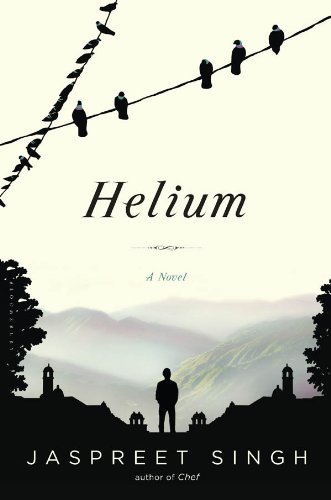Book Review: Helium by Jasprit Singh
Helium by Jasprit Singh (Published by Bloomsbury USA)
Reviewed by Saima Hussain
On November 1, 1984, 19-year-old Raj disembarked at New Delhi train station along with his classmates and professor, Mohan Singh. The group from Indian Institute of Technology (IIT) was returning from a class trip to Kasauli and Solan Hills. Some hours earlier they heard on the radio that prime minister Indira Gandhi had been assassinated by her Sikh bodyguards in retaliation for ordering an army operation inside the sacred Golden Temple in Amritsar earlier that year. What they had not heard was that violent mobs shouting khoon ka badla khoon (blood for blood) had taken over the city.
As the group gets off the train, several men smelling of rum and carrying metal rods approach them, having spotted the turbaned Professor Singh, the only Sikh in the group. The students spontaneously form a circle around him for protection but are unable to save him. A rubber tyre is flung around his neck, doused with petrol and set on fire. After his professor’s horrific death, Raj leaves to study chemical engineering in the United States and never returns, not even to attend his mother’s funeral. It is only after 25 years does he realise that the only way he can find peace is to confront the ghosts of 1984. Helium is Raj’s story.
Helium is a colourless, odourless, tasteless, non-toxic, inert, monatomic gas. It is everywhere and refuses to disappear, just like the past, which Raj believes clings to a person and refuses to let go. You can try to ignore it, to disown, or even change it to suit your taste but there it is: a mass of facts that will not dissolve or decimate. Chaurasi. Eight four. 1984. No matter how you write it or which language you say it in, the past is forever.
Raj returns to India to meet Singh’s wife and to face the perpetrators of those days of carnage. He knows he cannot hope to bring the criminals to justice; many of them are now cabinet ministers and chief ministers. But he still feels the need to come face-to-face with some of them, including his own father who was a senior police officer at the time. Confronting his father is as difficult as remembering the past.
Raj recalls the infamous words uttered by the incoming prime minister, Indira Gandhi’s son: “When a big tree falls the Earth shakes.” Rajiv Gandhi’s chilling analogy offered no consolation to the survivors of the violence; instead it provided cover to the policemen and army officers who looked the other way as thousands were tortured, raped, and killed. Some friends and neighbours came forward to rescue Sikhs, others colluded in their murder.
He remembers an incident that occurred a few days after the tragedy. One of the two Sikh boys in his class asked Raj to accompany him to a barber shop. The first barber refused to cut off his hair and the second did it only after being reassured that it was what he wanted. As they walked back through the city which “still smelled of burning rubber,” Raj asked his classmate how it felt. In response the boy “lifted his hand and slapped me.”
He recollects reading the words of Raj Singh, a survivor of the riots who was forced to flee Delhi for Panipat. Near Panipat, he was taken off the train by men in uniform and tortured in a prison inside an old fort: “Not a single year goes by when I don’t encounter a person from the diaspora who claims that ‘you Sikhs deserved what you got.’ ‘Achha hua.’ Huge violence in those two words. Often such characters are highly educated professionals. When I narrate the short version of my story their eyes pop out — but we never meet again.”
Raj then travels to Simla where he meets the beautiful and enigmatic Nelly, who was once more to him than just his professor’s wife. Nelly works at the Centre for Advanced Studies as the chief archivist — living in the past as it were. On the day her family was torn apart, Nelly was rescued by a prominent person who became her saviour but also turned out to be a chief perpetrator. From her hiding place she witnessed a group of women repeatedly gang raped and forced to parade naked. In the privacy of her home she reads children’s books aloud to maintain her equilibrium.
Helium is a difficult book to read. This is due to the painful descriptions of genocidal violence and individual guilt, and also because the narrative is quite literally a challenge to get through. Scientific observations about molecules and ornithology (the study of birds), quotes from the works of chemist and Holocaust survivor Primo Levi, and several black and white photos fill the pages alongside the account of Raj’s progression.
It is as if in this richly intertextual novel the author Jaspreet Singh, himself a chemical engineer by training, is recreating the workings of Raj’s burdened mind as he faces the distressing truth. But once you read through to the final page you feel strangely rewarded for having done so. You share Raj’s journey back to a devastating moment in history and learn from it at a safe distance. What happened in his country will never touch “us” because we are not like “them”, right?
While reading the novel one realises that their Chaurasi (’84) was not so different from our Ikhattar (’71). While they meted out collective punishment for a political murder, we meted out collective punishment for a political victory. The idea that power would transfer to East Pakistan and into the hands of Bengalis was so unfathomable that the result of a fairly won election had to be butchered. The leader of the losing party promised to “break the legs” of any elected member of his party who dared to attend the inaugural session of the National Assembly. There really is so much violence in words.
Jaspreet Singh reminds us how fragile society is and how easily that thin veneer of civility which controls human interactions can be ripped off. Who knows when the next violent mob will roam the city calling for collective punishment? How many friends and neighbours will rush to help? And how many educated professionals will say Achha hua.
*This review was originally published in DAWN, Mar. 30, 2014 www.dawn.com


